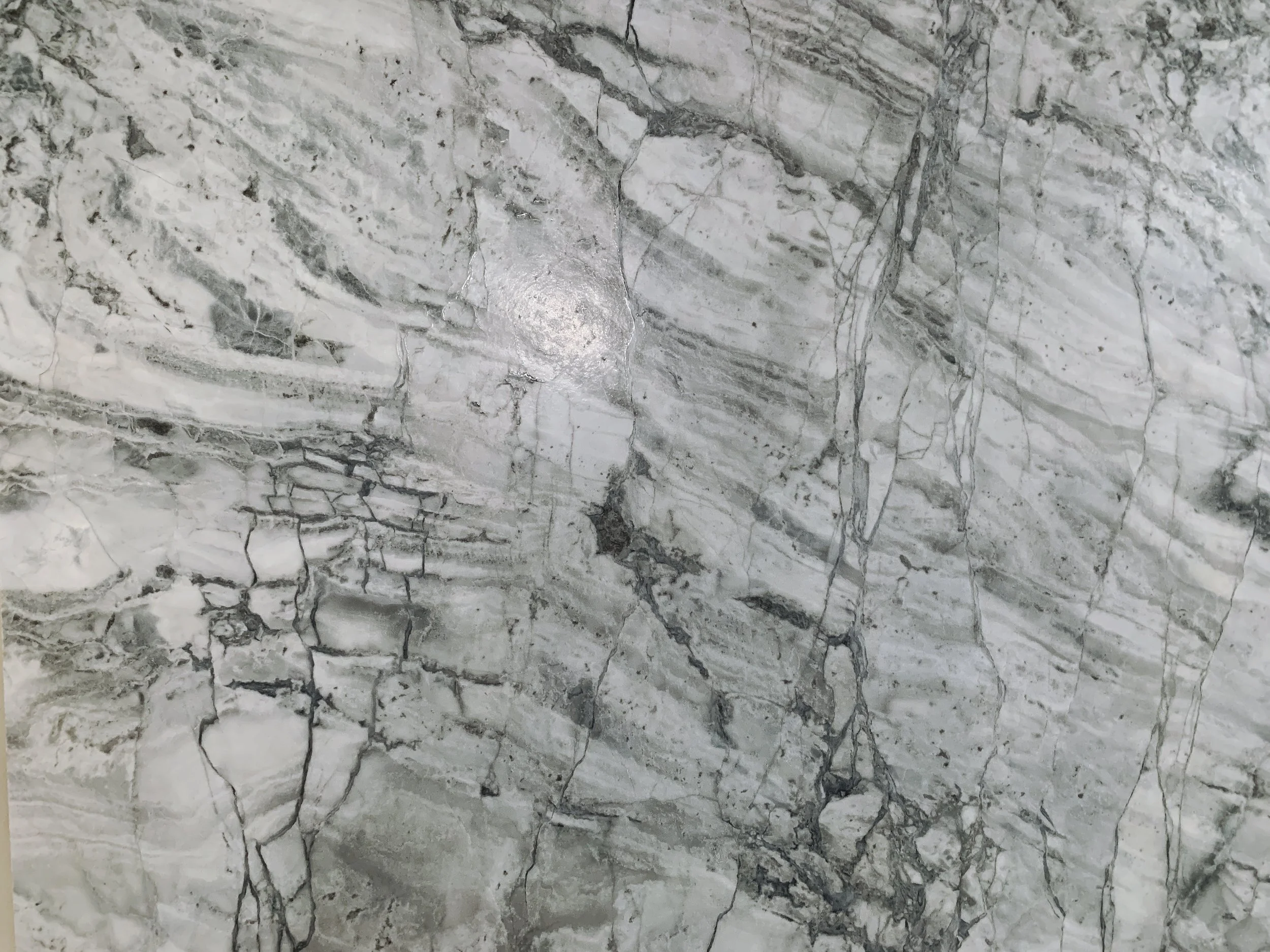Our Countertops + Backsplashes

We are finally starting to see some progress on our kitchen where it is beginning to look like a kitchen (if that makes any sense). The majority of the cabinets are installed (though many of the doors still need to be replaced unfortunately), the appliances are all installed (though the sink is waiting on the filtered cold water dispenser). And the most major elements that have made this room feel like a kitchen are the countertops and backsplashes are installed! Of course not without a hiccup though. They forgot to cut the drain grooves, which made me equally parts frustrated as it did stressed because they had to cut the grooves on site! Eek!
I’ve been getting a lot of questions about our countertop stone. Most of them are “What are they?!” or “Are those marble?” Which is funny because I didn’t actually know what it was when we selected it at the stone yard. I did know it was some sort of marble or marble like, because it’s within the same price point. But I have now found out it’s actually not marble.
What Type of stone is it?
Our countertops are a stone called Super White Dolomite. Super White Dolomite (according to wiki) is an exotic natural stone that has a desirable marble-look, but it actually is not marble. It is harder than typical marble and comes in large-sized slabs. There are a few variations of super white dolomite - super white calacatta, super white arabescato, super white light, and super white dark. I believe our stone is the super white light. It is also known as white fantasy. Super white is technically a quartzite, or as some geologists call it, dolomitic marble. Ack, so confusing right! Well here’s an easy way to understand what it is by understanding what it’s not.
Quartz vs Super White - Quartz is man-made. Super White is a natural stone.
Granite vs Super White - Granite is a felsic intrusive ingeous rock (this is the mineral make up and and their composition - crystallized at depth and rich in silica and predominately quartz plus potassium-rich feldspar plus sodium-rich plagioclase.) Super White is a metamorphic rock (a rock that has been changed by extreme heat and pressure).
Marble vs Super White - it is metamorphic just like marble, but is much harder than marble.
So this all means that Super White is none of the typical stones but acts and looks very much like an in-between of a marble and a granite.
Durability
On the Mohs test that measures how hard a material is, quartzite has a hardness mark of 8 of 10. It’s harder than glass and can actually cut glass(!) That means that Super White is more durable than marble! Also, Super White is naturally stain-proof. Etching it with water is impossible, high functionality is one of its main characteristics. However, it is not indestructible. If you have a quartzite countertop that etches that’s because it’s not purely 100% quartzite. Installers will seal the stone, but also it is recommended that you have this stone sealed regularly (once a year is good).
I am in the house of don’t take chances if you would not be happy with negative results. If you’re the kind of person who wouldn’t care if your stone etches or shows wear, then go ahead, live your life and enjoy the aging process of the stone. However, if you would panic if you saw etching marks or stains then take the precautions to clean up after yourself immediately, don’t leave lemon juice or red wine out on your counters and definitely do not clean your counters with harsh chemicals. Why would you want to take the risk?
From a design perspective I think it’s a beautiful option for a home that is more concerned with durability than with the entitlement of having marble countertops. I have some clients who have been warned about marble but are just so obsessed with the idea of marble, they are willing to change their lives to live with marble. While others are not, and that’s why I recommend other stone options. However, I also have clients who believe they want both and have been disappointed with marble because it’s not ‘perfect’. And that is the reality of a natural material. It’s imperfect, it ages, and it’s beautiful because of these traits, and you should not expect it to be perfect.
Price point
Super white is not cheaper than marble. Our slabs were actually more expensive than carrara marble. One thing that many people do not understand about natural stone is that the prices vary by every slab. Carrara can be less expensive than some quartzite stones (i.e. dolomite) but Calacatta marble is probably the most expensive. This is because of the quarries they come out of, the color variations and accessibility of the stones, not because of the durability.
Why did we choose these countertops?
The funny thing is that I actually had no idea that Super White was more durable than marble. I was ready to take on the aging characteristics of marble as long as I enjoyed the color, veining and price. My husband will tell you, he’s a little more concerned with the wear of the stone. But I didn’t care, because marble is beautiful as it ages and gets chipped and worn. I truly love that about marble. I was ultimately more concerned with the color of the stone and how strong the veining was. I wanted a calacatta look with intense veining, but a very neutral color and I was getting tired of using carrara so much with projects that I just didn’t want to use it in my own home. I did consider soapstone, however I wanted the kitchen to feel a little lighter than darker, so I moved away from soapstone.
The other element about our countertops which is interesting is that we selected the leather finish. Something I’d seen on granite and never really liked but loved on our slabs. It’s a finish where they bring out the feel of the veining so that the surface isn’t super smooth, it has a slight sheen yet it’s not polished nor honed. I was thinking that this would potentially help hide etching and scratching if the material did end up being as soft as marble. I guess I lucked out on all fronts here!








